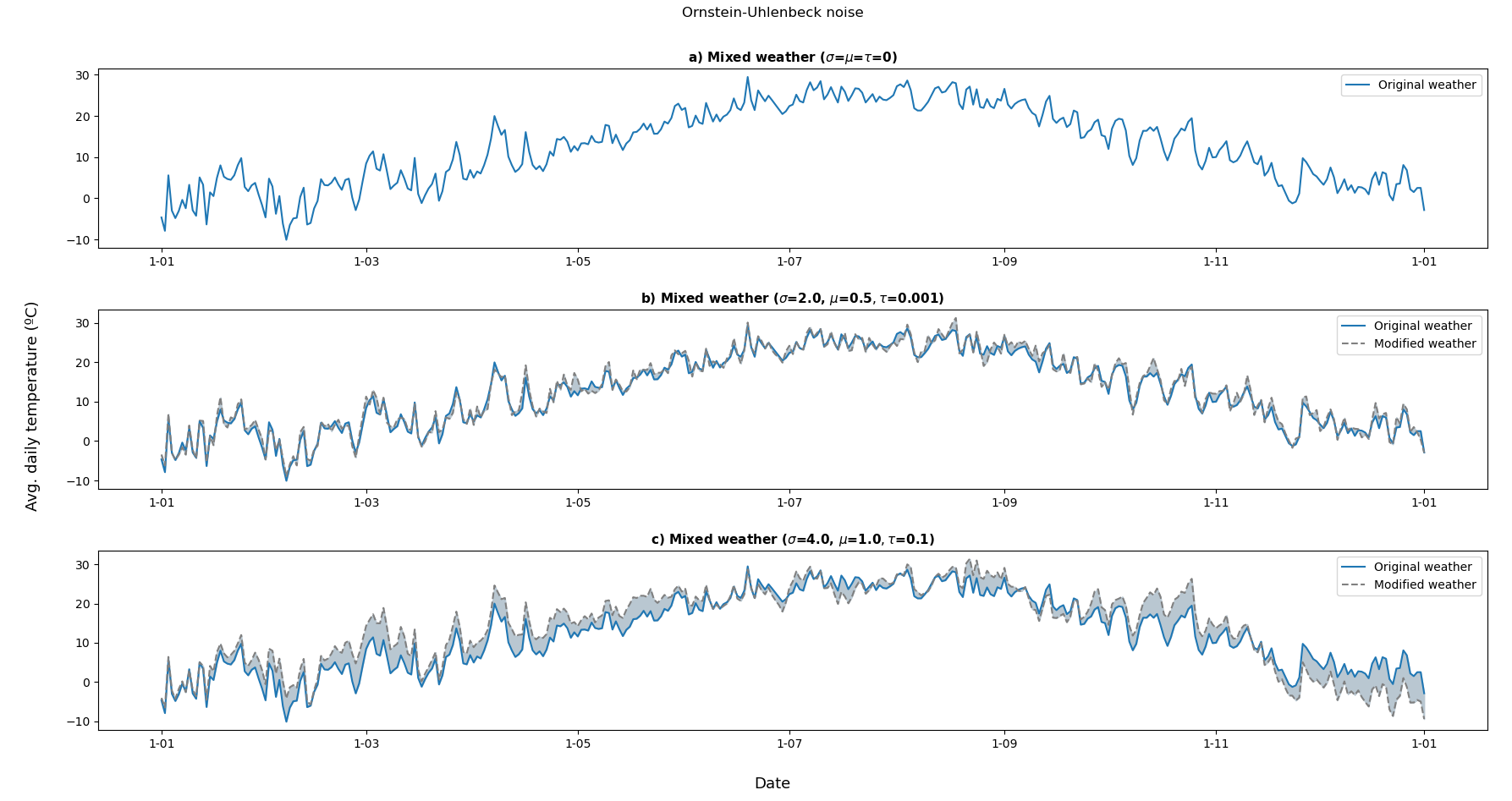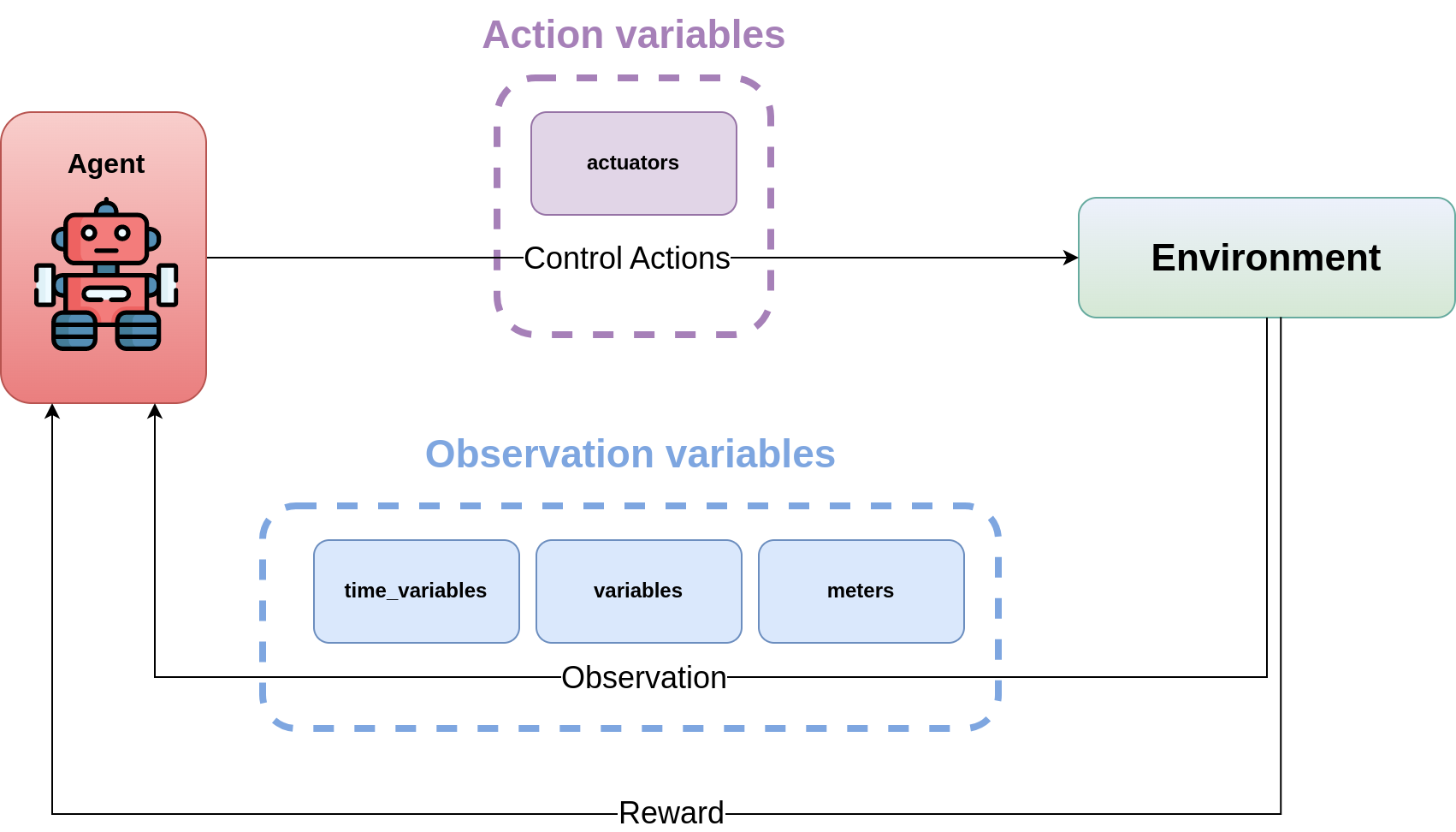6. Environments
Sinergym generates multiple environments for each building, each defined by a unique configuration that outlines the control problem to be solved. To view the list of available environment IDs, it is recommended to use the provided method:
# This script is available in scripts/consult_environments.py
import sinergym
import gymnasium as gym
from sinergym.utils.common import get_ids
# Get the list of available environments
sinergym_environment_ids = get_ids()
print(sinergym_environment_ids)
# Make and consult some of the environments
env = gym.make('Eplus-5zone-hot-continuous-stochastic-v1')
print(env.info())
Environment names adhere to the pattern Eplus-<building-id>-<weather-id>-<control_type>-<stochastic (optional)>-v1.
These IDs offer a general overview of the environment. For more detailed information about each environment,
utilize the info method as demonstrated in the example code.
Important
As of Sinergym v3.0.9, environments are automatically generated using JSON configuration files for each building, eliminating the need for manual registration of each environment ID with parameters set directly in the environment constructor. Refer to Environments Configuration and Registration for more details.
Note
Discrete environments are customizable. The default control for these environments is quite basic. You can employ a continuous environment and customize discretization using our dedicated wrapper. For more information, see DiscretizeEnv.
Note
For additional details on the buildings (epJSON) and weather conditions (EPW) used, please visit the Buildings and Weathers sections respectively.
6.1. Available Parameters
With the environment constructor, we can configure the complete context of our environment for experimentation, either starting from one predefined by Sinergym or creating a new one.
Sinergym initially provides non-configured buildings and weathers.
Depending on these argument values, these files are updated to adapt to these
new features, this will be done by Sinergym automatically. For example, using
another weather file requires updating the building location and design days,
using new observation variables requires updating the Output:Variable and
Output:Meter fields, the same occurs with extra configuration context
concerned with simulation directly, if weather variability is set, then a weather
with noise will be used. These new building and weather file versions are saved in
the Sinergym output folder, leaving the original intact.
The next subsections will show which parameters are available and what their functions are:
6.1.1. building file
The parameter building_file is the epJSON file, a new
adaptation of IDF
(Intermediate Data Format) where EnergyPlus building model is defined. These
files are not configured for a particular environment as we have mentioned.
Sinergym does a previous building model preparation to the simulation, see the
Modeling element in Sinergym backend diagram.
6.1.2. Weather files
The parameter weather_file is the EPW (EnergyPlus Weather) file name where
climate conditions during a year is defined.
This parameter can be either a weather file name (str) as mentioned, or a list
of different weather files (List[str]). When a list of several files is defined,
Sinergym will select an EPW file in each episode and re-adapt the building model
randomly. This is done to increase the complexity in the environment if desired.
The weather file used in each episode is stored in Sinergym episode output folder, if variability (section Weather Variability is defined), the EPW stored will have that noise included.
6.1.3. Weather Variability
Weather variability can be integrated into an environment using the
weather_variability parameter.
It implements the Ornstein-Uhlenbeck process to introduce noise to the weather data episode to episode. Then, the parameter established is a Python tuple of three variables (sigma, mu, and tau) whose values define the nature of that noise.

6.1.4. Reward
The parameter called reward is used to define the reward class
(see section Rewards) that the environment is going to use to
calculate and return scalar reward values each timestep.
6.1.5. Reward Kwargs
Depending on the reward class that is specified to the environment, it may have different arguments depending on its type. In addition, if a user creates a new custom reward, it can have new parameters as well.
Moreover, depending on the building being used for the environment, the values of these reward parameters may need to be different, such as the comfort range or the energy and temperature variables of the simulation that will be used to calculate the reward.
Then, the parameter called reward_kwargs is a Python dictionary where
we can specify all reward class arguments that they are needed. For
more information about rewards, visit section Rewards.
6.1.6. Maximum Episode Data Stored in Sinergym Output
Sinergym stores all the output of an experiment in a folder organized in
sub-folders for each episode (see section Output format for more
information). Depending on the value of the parameter max_ep_data_store_num,
the experiment will store the output data of the last n episodes set,
where n is the value of the parameter.
In any case, if Sinergym CSV storage (See CSVLogger section) is activated,
progress.csv will be present with the summary data of each episode.
6.1.7. Time variables
EnergyPlus Python API has several methods in order to extract information
about simulation time in progress. The argument time_variables is a list
in which we can specify the name of the
API methods
whose values we want to include in our observation.
By default, Sinergym environments will have the time variables
month, day_of_month and hour.
6.1.8. Variables
The argument called variables is a dictionary in which it is specified
the Output:Variable’s we want to include in the environment observation.
The format of each element, in order for Sinergym to process it, is the next:
variables = {
# <custom_variable_name> : (<"Output:Variable" original name>,<variable_key>),
# ...
}
Note
For more information about the available variables in an environment, execute a default simulation with EnergyPlus engine and see RDD file generated in the output.
6.1.9. Meters
In a similar way, the argument meters is a dictionary in which we can specify
the Output:Meter’s we want to include in the environment observation.
The format of each element must be the next:
meters = {
# <custom_meter_name> : <"Output:Meter" original name>,
# ...
}
Note
For more information about the available meters in an environment, execute a default simulation with EnergyPlus engine and see MDD and MTD files generated in the output.
6.1.10. Actuators
The argument called actuators is a dictionary in which we specify the actuators we
want to control with gymnasium interface, the format must be the next:
actuators = {
# <custom_actuator_name> : (<actuator_type>,<actuator_value>,<actuator_original_name>),
# ...
}
Important
Actuators that have not been specified will be controlled by the building’s default schedulers.
Note
For more information about the available actuators in an environment, execute a default control with
Sinergym directly (empty action space) and see data_available.txt generated.
6.1.11. Action space
In Sinergym, the environment’s observation and action spaces are defined through the
arguments time_variables, variables, meters, and actuators. The
observation space, composed of time_variables, variables, and meters, is
automatically generated. The action space, defined by the actuators, requires explicit
definition to establish the range of values supported by the Gymnasium interface or the number
of discrete values in a discrete environment.

The action_space argument adheres to the Gymnasium standard and must be a continuous
space (gym.spaces.Box) due to the EnergyPlus simulator’s continuous value
requirement. It’s crucial that this definition aligns with the previously defined actuators,
with Sinergym highlighting any inconsistencies.
Note
To adapt an environment to Gymnasium’s Discrete, MultiDiscrete, or MultiBinary spaces,
akin to our predefined discrete environments, consult the section DiscretizeEnv and the
example in Environment Discretization Wrapper.
Important
While Sinergym’s environments come with predefined observation and action variables ( details available in default_configuration), users are encouraged to explore and experiment with these spaces. For guidance, refer to Changing observation and action spaces.
Sinergym also provides the option to create empty action interfaces, allowing users to leverage its benefits without directly using the EnergyPlus simulator. Control in this scenario is managed by the default building model schedulers. For further details, refer to the usage example Default building control setting up an empty action interface.
6.1.12. Environment Name
The env_name parameter is utilized to generate the working directory name,
facilitating differentiation between multiple experiments within the same environment.
6.1.13. Extra Configuration
Parameters related to the building model and simulator, such as people occupant, timesteps per simulation hour,
and runperiod, can be set as extra configurations. These configurations, which may expand in the future,
are specified in the config_params argument, a Python Dictionary. For additional information
on extra configurations in Sinergym, refer to Extra Configuration in Sinergym simulations.
6.2. Adding New Weathers for Environments
Sinergym provides a variety of weather files for diverse global climates to enhance experimental diversity.
To incorporate a new weather:
Download an EPW and its corresponding DDY file from the EnergyPlus page. The DDY file provides location and design day details.
Ensure both files share the same name, differing only in their extensions, and place them in the weathers folder.
Upon addition, Sinergym will automatically modify the SizingPeriod:DesignDays and Site:Location
fields in the building model file using the DDY file.
6.3. Adding New Buildings for Environments
Users can either modify existing environments or create new ones, incorporating new climates, action, and observation spaces. They also have the option to use a different building model (epJSON file) than the ones currently supported.
To add new buildings for use with Sinergym, follow these steps:
Add your building file (epJSON) to the buildings directory. Ensure it’s compatible with the EnergyPlus version used in Sinergym. If you’re using an IDF file from an older version, update it with IDFVersionUpdater and convert it to epJSON format using ConvertInputFormat. Both tools are available in the EnergyPlus installation folder.
Adjust building objects like
RunPeriodandSimulationControlto suit your needs in Sinergym. We recommend settingrun_simulation_for_sizing_periodstoNoinSimulationControl.RunPeriodsets the episode length, which can be configured in the building file or Sinergym settings (see runperiod). Make these modifications in the IDF before step 1 or directly in the epJSON file.Identify the components of the building that you want to observe and control. This is the most challenging part of the process. Typically, users are already familiar with the building and know the name and key of the elements in advance. If not, follow the process below:
Run a preliminary simulation with EnergyPlus directly, without any control flow, to view the different
OutputVariablesandMeters. Consult the output files, specifically the RDD extension file, to identify possible observable variables.The challenge is knowing the names but not the possible Keys (EnergyPlus doesn’t initially provide this information). Use these names to define the environment (see step 4). If the Key is incorrect, Sinergym will notify you of the error and provide a data_available.txt file in the output, as it has already connected with the EnergyPlus API. This file contains all the controllable schedulers for the actions and all the observable variables, now with their respective Keys, enabling the correct definition of the environment.
With this information, the next step is defining the environment using the building model. You have several options:
Use the Sinergym environment constructor directly. The arguments for building observation and control are explained within the class and should be specified in the same format as the EnergyPlus API.
Set up the configuration to register environment IDs directly. For more information, refer to the documentation Environments Configuration and Registration. Sinergym will verify that the established configuration is correct and notify you of any potential errors.
If you’ve used Sinergym’s registry, you’ll have access to environment IDs associated with your building. Use them with
gym.make(<environment_id>)as usual. If you’ve created an environment instance directly, use that instance to start interacting with the building.
Note
To obtain information about the environment instance with the new building model, refer to Getting information about Sinergym environments.